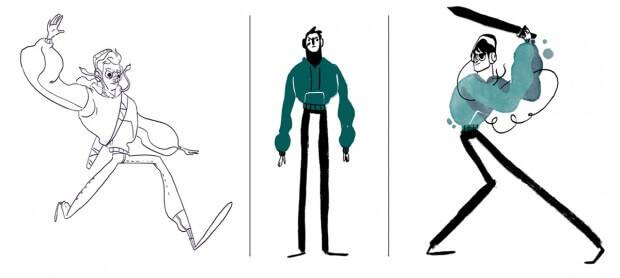Tako Faito – Serving up a Success
Tako Faito is an experimental piece of animation straight from the canadian studio Giant Ant. As they had a little bit of spare time between commercial work, there animators decided to push their cel animation with this fast paced short animation. The adventure of one young man and his lunch. Although it may be short it’s a beautiful piece of work and we just had to catch up with animator Henrique Barone to find out more about this sensational short.
There’s no one director declared, it’s clearly a collaborative piece, but what inspired the story of a samurai fighting for his lunch, are there many fights in the studio over lunch?
You are right, it’s a collaborative piece. There wasn’t a lot of actual goals other than explore and push our cel character animation in a character-driven piece. Everybody was happy to start working from the first thumbs, which presented a guy jumping around while being chased by a huge tentacle. The tentacle was an interesting obstacle because it would move in a more organic, fluid way, in opposition to the character, which could have sharper and quicker moves. On top of that, we added the idea that the tentacle was actually his meal, and that helped bring a bit more depth to the story, giving it a nice little “plot twist”, so the viewer feels it’s not only a cool piece to look at, but it also pays off in the end.
How is Giant Ant set up as a studio?
Giant Ant is a family of writers and directors, animators and editors. We’re designers and cinematographers, producers and composers. We believe in collaborating with the very best talent in the industry to create meaningful and creative work for a select list of clients that we respect.
In the description it’s says you were trying to push the elements of cel animations, and it clearly does this through very exciting, fast paced camera movement and all kinds of perspectives, how did you achieve this?
It was a cool challenge! Most of the cameras were suggested in the storyboard and then tested out and improved in the animation stage. The final result for the camera is a mix of frame by frame work and composite in After Effects, where we also add some subtle yet important camera movements.
Was inspiration from other pieces of work taken for this, did you do much research or jump straight into it?
As with any project at Giant Ant, we talk about other pieces we think have the same mood we are trying to convey, then we gather some of those and start nailing down the style. In terms of art, we were aiming for a character that would be detailed enough for us to push our boundaries, but also easy enough for us to not get stuck in the project. So our character is a nice mix of a more detailed design (similar to Gobelins or Disney), plus a more painterly, free, independent short film kind of look.
In terms of inspiration for animation and the action shot and camera perspectives, I’d point out Samurai Jack and Disney’s Tarzan as the main ones, among many other amazing shorts and animated pieces out there.
The split screen making-of shows everyone the several step process and hard work that’s gone into this piece of work, we also can see the development of the character’s through the and style, was the style always there in your mind?
No. At the beginning he was more of a Parkour/City boy, who would be jumping between back alley fire stairs and building rooftops, but as the concept of him eating Japanese food started to pop up, the idea of making him sort of a modern Ninja, felt very interesting; so we shifted both the character design and the art direction the same way. The final design uses some heavy brush strokes and a limited black and red palette, resembling traditional Japanese ink wash painting.
If you were to do it again would you do any of this differently?
Not really. We learned a lot with Tako Faito! and are super happy with the results of it. We want to do more projects that are similar to that.
What’s the most important thing you’ve taken from the project? Do you have any advice for anyone looking to experiment and push their cel animation like yourselves?
This is a frame by frame project, so it was very important to stick to process as much as we could. In a ‘not-too-hand-drawn-project’ it’s easier to start messing around with breakdowns and inbetweens, even when you don’t have all the key-frames there yet (or you are not super sure about them). That works ok and it’s actually pretty good for projects where you need to see or show more stuff ‘done’, but for a project like Tako Faito!, the plan was to approach it as ‘step by step’ as we could.
CREDITS:
Creative & Story: Henrique Barone, Rafael Mayani, Jay Grandin, Jorge Canedo Estrada
Producer: Cory Philpott
Art Direction: Rafael Mayani
Animation: Henrique Barone
Compositing: Matt James
Music & Sound Design: CypherAudio



